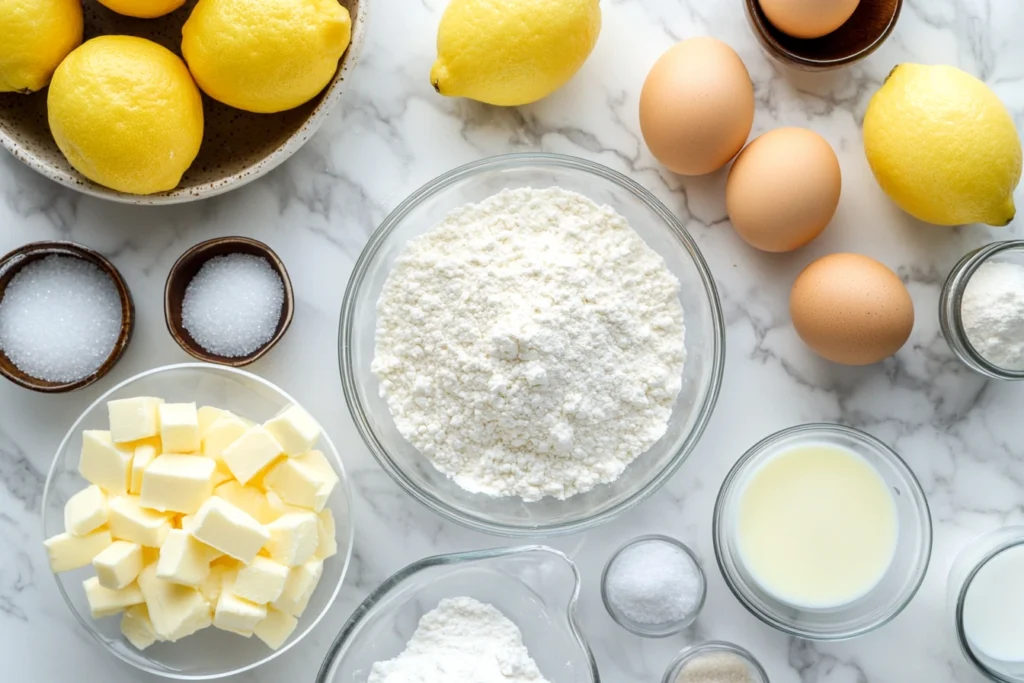Lemon pound cake is a timeless dessert that perfectly balances rich, buttery texture with a refreshing citrus zing. Whether enjoyed as a breakfast treat, an afternoon snack, or dessert, this classic cake has won the hearts of many. Its dense yet moist crumb, combined with the bright flavor of lemon, makes it a delightful choice for all occasions.
Originating from the traditional pound cake recipe—where equal parts of flour, butter, sugar, and eggs were used—the lemon version adds a refreshing twist. The addition of lemon zest and juice enhances the flavor, creating a cake that is both indulgent and refreshing.
From bakeries to home kitchens, lemon pound cake is a favorite among those who appreciate simple yet flavorful baked goods. Whether glazed with a sweet lemon drizzle or served plain, it is a crowd-pleaser that never goes out of style. In this article, we’ll explore the secrets to making the perfect lemon pound cake, including step-by-step instructions, variations, serving tips, and more.
Table of Contents
What is Lemon Pound Cake?
Lemon pound cake is a variation of the classic pound cake, infused with the bright, zesty flavor of lemon. Traditionally, pound cakes were made with equal parts butter, sugar, eggs, and flour, resulting in a dense and rich texture. Over time, bakers began modifying the recipe to introduce new flavors, with lemon being one of the most popular choices.
For those who love citrusy desserts, you might also enjoy these 2-Ingredient Lemon Bars, a quick and easy recipe with just the right amount of tang.
What Makes Lemon Pound Cake Unique?
Unlike traditional pound cake, lemon pound cake incorporates:
- Lemon Zest and Juice – Enhances the flavor with natural citrus oils and acidity.
- Baking Powder or Baking Soda – Modern recipes include a leavening agent to make the cake slightly lighter.
- Milk or Buttermilk – Some variations add dairy for extra moisture.
- Glaze or Frosting – A sweet lemon glaze is often drizzled on top for added flavor and visual appeal.
Lemon pound cake is perfect for those who love a balance of richness and tanginess. Whether served plain, dusted with powdered sugar, or covered in a sweet glaze, it remains a beloved treat.
Step-by-Step Recipe for Lemon Pound Cake
Now that we’ve covered the essential ingredients, let’s dive into the step-by-step process for making the perfect lemon pound cake. Follow these detailed instructions to achieve a moist, flavorful cake with a golden crust and tender crumb.
Ingredients

For the Cake:
- 2 ½ cups (315g) all-purpose flour
- 1 cup (225g) unsalted butter, softened
- 1 ¾ cups (350g) granulated sugar
- 4 large eggs, room temperature
- ⅓ cup (80ml) freshly squeezed lemon juice
- 2 tablespoons lemon zest
- 1 teaspoon vanilla extract
- ½ teaspoon salt
- 1 teaspoon baking powder
- ½ cup (120ml) buttermilk (or whole milk)
For the Lemon Glaze (Optional):
- 1 cup (120g) powdered sugar
- 2 tablespoons of lemon juice
- 1 teaspoon lemon zest
Step 1: Preheat the Oven & Prepare the Pan
Preheat your oven to 350°F (175°C). Grease and flour a 9×5-inch loaf pan or line it with parchment paper for easy removal. If using a bundt pan, make sure all crevices are coated to prevent sticking.
Step 2: Cream Butter & Sugar
In a large mixing bowl, beat the softened butter and sugar together using a hand mixer or stand mixer on medium-high speed until the mixture becomes light and fluffy (about 3-5 minutes). This step is crucial for creating a tender cake.
Step 3: Add Eggs One at a Time
Reduce the mixer speed to medium and add the eggs one at a time, beating well after each addition. This ensures the eggs are fully incorporated and helps create a smooth batter.
Step 4: Incorporate Lemon & Vanilla Flavors
Add the lemon zest, lemon juice, and vanilla extract to the batter and mix until combined. The mixture may look slightly curdled at this stage—this is normal.
Step 5: Combine Dry Ingredients
In a separate bowl, whisk together the flour, baking powder, and salt. Gradually add this mixture to the batter, alternating with the buttermilk. Begin and end with the dry ingredients, mixing on low speed until just combined. Avoid overmixing to keep the cake tender.

Step 6: Bake the Cake
Pour the batter into the prepared pan and spread it evenly. Bake in the preheated oven for 55-65 minutes or until a toothpick inserted in the center comes out clean. If using a bundt pan, baking time may vary slightly.
Step 7: Cool the Cake
Allow the cake to cool in the pan for 10-15 minutes, then transfer it to a wire rack to cool completely before adding the glaze.
Step 8: Prepare & Apply the Lemon Glaze (Optional)
For an extra burst of flavor, mix the powdered sugar, lemon juice, and lemon zest in a small bowl until smooth. Drizzle over the cooled cake and let it set before slicing.
Final Tips for Success:
✔ Use fresh lemons for the best flavor. Bottled lemon juice lacks the brightness needed for this recipe.
✔ Room temperature ingredients ensure a smooth batter and even baking.
✔ Do not overmix the batter after adding the flour to prevent a dense cake.
✔ Check for doneness by inserting a toothpick in the center; it should come out clean or with a few crumbs.
For another moist and flavorful baked good, check out this Cinnamon Banana Bread—a warm and spiced delight.
Tips for Making the Best Lemon Pound Cake
Making a perfect lemon pound cake requires attention to detail and a few expert tips to ensure the best texture and flavor. Below are some key techniques to help you bake a moist, rich, and flavorful cake every time.
1. Use Fresh Lemons for Maximum Flavor
The key to a truly zesty lemon pound cake is fresh lemons. Always use freshly squeezed lemon juice and zest for the best citrus flavor. Avoid bottled lemon juice, as it lacks the essential oils and brightness found in fresh lemons.
💡 Tip: When zesting lemons, only remove the yellow outer layer—the white pith underneath is bitter and can alter the cake’s taste.
2. Cream the Butter and Sugar Properly
One of the most important steps in making pound cake is creaming the butter and sugar together until light and fluffy. This process incorporates air into the batter, helping to create a tender and slightly airy texture.
💡 Tip: Beat butter and sugar for at least 3-5 minutes on medium-high speed until the mixture is pale and fluffy.
3. Use Room Temperature Ingredients
Cold ingredients do not mix well, resulting in an uneven batter. To ensure a smooth and uniform mixture, allow the butter, eggs, and milk (or buttermilk) to come to room temperature before baking.
💡 Tip: If you forget to bring eggs to room temperature, place them in warm water for 5-10 minutes before using.
4. Measure Ingredients Accurately
Baking is a science, and even slight measurement errors can affect the cake’s texture. Always use a kitchen scale for the most precise results, especially when measuring flour.
💡 Tip: If using measuring cups, spoon and level the flour instead of scooping directly from the bag. This prevents adding too much flour, which can lead to a dry cake.
Variations of Lemon Pound Cake
Lemon pound cake is a versatile dessert that can be adapted to fit different dietary needs and flavor preferences. Whether you need a gluten-free, dairy-free, keto, or vegan version or just want to experiment with exciting flavor combinations, there’s a variation for everyone.
1. Gluten-Free Lemon Pound Cake
For those with gluten sensitivities or celiac disease, a gluten-free version of lemon pound cake is an excellent option.
How to Make It Gluten-Free:
- Use a 1:1 gluten-free flour blend (such as Bob’s Red Mill or King Arthur Baking) instead of all-purpose flour.
- Add ½ teaspoon of xanthan gum (if your flour blend doesn’t already include it) to help with structure.
- Be careful not to overmix, as gluten-free flour can become gummy if overworked.
💡 Tip: Let the batter rest for 15-20 minutes before baking to allow the flour to hydrate, resulting in a better texture.
2. Dairy-Free Lemon Pound Cake
For a lactose-free or dairy-free version, simple substitutions can be made without sacrificing flavor or texture.
Dairy-Free Ingredient Swaps:
- Replace butter with an equal amount of vegan butter or coconut oil.
- Use almond milk, oat milk, or coconut milk instead of buttermilk. Add 1 teaspoon of lemon juice to mimic the acidity of buttermilk.
- Check your sugar and flour brands to ensure they are certified dairy-free.
💡 Tip: Coconut oil can add a subtle coconut flavor, so use refined coconut oil if you prefer a neutral taste.
3. Keto & Low-Carb Lemon Pound Cake
A keto-friendly lemon pound cake is perfect for those following a low-carb or sugar-free diet.
Keto-Friendly Adjustments:
- Use almond flour or coconut flour instead of all-purpose flour. Almond flour provides a dense texture similar to traditional pound cake.
- Replace granulated sugar with a keto-friendly sweetener like erythritol, monk fruit, or allulose.
- Swap regular milk with heavy cream or unsweetened almond milk.
- Add 1 teaspoon of xanthan gum to improve texture and structure.
💡 Tip: Since almond flour is denser, your cake may need extra eggs (about 5 instead of 4) to help with moisture and rise.
4. Vegan Lemon Pound Cake
To make a completely plant-based lemon pound cake, you’ll need to substitute both eggs and dairy ingredients.
Vegan Ingredient Replacements:
- Butter substitute: Use vegan butter or coconut oil.
- Egg replacement: Use one of the following options per egg:
- ¼ cup unsweetened applesauce
- 1 tablespoon ground flaxseed mixed with 3 tablespoons of water (let sit for 5 minutes)
- ¼ cup mashed banana (this adds a slight banana flavor)
- Milk substitute: Use almond, oat, or soy milk.
- Sweetener: Ensure the sugar is vegan-certified (some sugars are processed with bone char).
💡 Tip: Adding a bit of extra baking powder (½ teaspoon) helps with rise and fluffiness since eggs act as a binder in traditional recipes.
Frequently Asked Questions (FAQs) About Lemon Pound Cake
1. What are the best lemons to use for lemon pound cake?
Fresh Meyer or Eureka lemons are best. Meyer lemons are sweeter, while Eureka lemons have a stronger citrus flavor.
2. How do I prevent my lemon pound cake from becoming dry?
Measure flour correctly, do not overmix the batter, and bake at the correct temperature. Using buttermilk or sour cream can help retain moisture.
3. Can I make lemon pound cake without baking powder?
Yes, but the texture will be denser. You can use baking soda with an acidic ingredient like buttermilk or yogurt as a substitute.
4. How do I store lemon pound cake?
Store it in an airtight container at room temperature for up to three days or refrigerate for up to a week. Freeze for longer storage.
Conclusion
Lemon pound cake is a classic dessert with a perfect balance of rich texture and bright citrus flavor. With the right ingredients and techniques, you can make a moist, flavorful cake every time. Whether served plain, glazed, or with fruit, it’s a versatile treat for any occasion. Simple to make and easy to store, it remains a timeless favorite.
For more delicious baked goods, explore Mini Cupcakes or indulge in a Brookie Recipe: Brownie Cookie Delight for a mix of chewy and fudgy goodness.
No matter how you enjoy it, lemon pound cake remains a staple in any baker’s repertoire. Happy baking! 🍋🍰
Print
Lemon Pound Cake
- Total Time: 75 minutes
- Yield: 1 loaf (8-10 servings) 1x
Description
This classic Lemon Pound Cake is rich, buttery, and bursting with bright citrus flavor. With a tender crumb and a golden crust, it’s the perfect dessert for lemon lovers. Topped with a sweet and tangy lemon glaze, this cake pairs wonderfully with a cup of tea or coffee. Whether for a special occasion or a simple afternoon treat, this homemade lemon pound cake is guaranteed to impress!
Ingredients
For the Cake:
- 2 ½ cups (315g) all-purpose flour
- 1 cup (225g) unsalted butter, softened
- 1 ¾ cups (350g) granulated sugar
- 4 large eggs, room temperature
- ⅓ cup (80ml) freshly squeezed lemon juice
- 2 tablespoons lemon zest
- 1 teaspoon vanilla extract
- ½ teaspoon salt
- 1 teaspoon baking powder
- ½ cup (120ml) buttermilk (or whole milk)
For the Lemon Glaze (Optional):
- 1 cup (120g) powdered sugar
- 2 tablespoons of lemon juice
- 1 teaspoon lemon zest
Instructions
- Preheat the Oven & Prepare the Pan: Preheat your oven to 350°F (175°C). Grease and flour a 9×5-inch loaf pan or line it with parchment paper for easy removal. If using a bundt pan, ensure all crevices are coated to prevent sticking.
- Cream Butter & Sugar: In a large mixing bowl, beat the softened butter and sugar together using a hand or stand mixer on medium-high speed until the mixture becomes light and fluffy (about 3-5 minutes). This step is crucial for creating a tender cake.
- Add Eggs One at a Time: Reduce the mixer speed to medium and add the eggs one at a time, beating well after each addition. This ensures the eggs are fully incorporated and creates a smooth batter.
- Incorporate Lemon & Vanilla Flavors: Add the lemon zest, lemon juice, and vanilla extract to the batter and mix until combined. The mixture may look slightly curdled at this stage—this is normal.
- Combine Dry Ingredients: In a separate bowl, whisk together the flour, baking powder, and salt. Gradually add this mixture to the batter, alternating with the buttermilk. Begin and end with the dry ingredients, mixing on low speed until just combined. Avoid overmixing to keep the cake tender.
- Bake the Cake: Pour the batter into the prepared pan and spread it evenly. Bake in the preheated oven for 55-65 minutes or until a toothpick inserted in the center comes out clean. If using a bundt pan, baking time may vary slightly.
- Cool the Cake: Allow the cake to cool in the pan for 10-15 minutes, then transfer it to a wire rack to cool completely before adding the glaze.
- Prepare & Apply the Lemon Glaze (Optional): For an extra burst of flavor, mix the powdered sugar, lemon juice, and lemon zest in a small bowl until smooth. Drizzle over the cooled cake and let it set before slicing.
Notes
- Use fresh lemons: Freshly squeezed lemon juice and zest provide the best citrus flavor. Avoid bottled lemon juice.
- Room temperature ingredients: Ensure butter, eggs, and buttermilk are at room temperature for even mixing.
- Avoid overmixing: Overmixing the batter can result in a dense cake. Mix just until the ingredients are combined.
- Storage tip: Store the cake in an airtight container at room temperature for up to 3 days, or refrigerate for up to a week.
- Prep Time: 15 minutes
- Cook Time: 60 minutes
- Category: Dessert
- Method: Baking
Nutrition
- Serving Size: 1 slice (based on 10 slices)
- Calories: 380
- Sugar: 35g
- Sodium: 180mg
- Fat: 18g
- Saturated Fat: 10g
- Unsaturated Fat: 8g
- Trans Fat: 0g
- Carbohydrates: 50g
- Fiber: 1g
- Protein: 5g
- Cholesterol: 85mg

